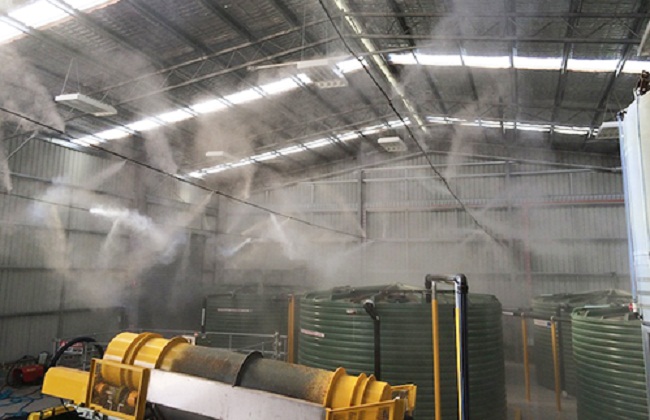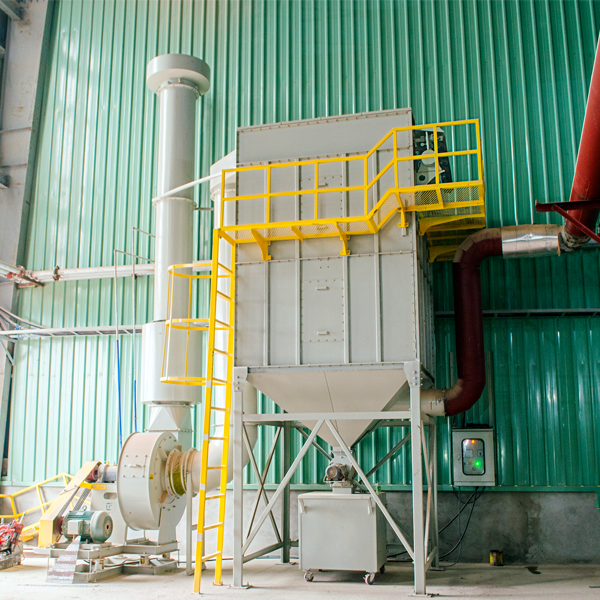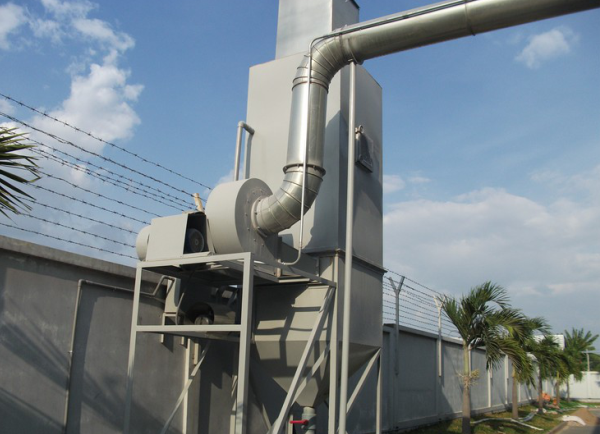Today, along with the development of industry, the air environment becomes more polluted, causing serious consequences affecting the ecological environment. Businesses have begun to pay attention to dust treatment methods to protect the living environment in general and the working environment in particular. Let’s take a look at the highly effective dust treatment methods used by P69 Company in this article !
What is industrial dust?
Dust is a collection of different compounds with very distinct large and small sizes, some of which are too small to be seen and are always suspended in the air. Dust is divided into two main types: flying dust and settling dust.
Industrial dust generated through the process of working, building construction, factories, manufacturing – transporting products, etc. has created a large amount of dust that is released into the environment.

Industrial dust not only directly affects the health of workers but also affects the lives of people around. It is for this reason that the thorough treatment of this dust is an urgent requirement.
Basic effects of dust
– For man
- Flying dust often causes severe damage to the respiratory organs
- Dust deposits often damage the skin, eyes, cause infections, cause skin allergies, …
– For the environment:
- Reduce sunlight intensity.
- Increased wear of machine parts.
- Reduces plant growth.
- Creates an environment for harmful bacteria to grow.
– For machines, factories
- Clinging to machinery and equipment reduces the life of machinery and equipment.
- Clinging to the bearings increases friction.
- Sticking to the electric motor circuits causes a short circuit and can burn the electric motor.
- Affect the finished product during production.
The most effective dust treatment method is used
The problem of dust treatment in factories and industrial parks has been and is being concerned. Depending on the scale, investment costs as well as the nature of each type of dust, there are now many different dust treatment methods. Dust treatment options will help to absorb and filter the maximum amount of dust, improve air quality and ensure safety for workers’ health. Let’s find out the dust treatment measures below.
1. Industrial dust treatment by dust treatment system by dust filter bag
The dust treatment system with a dust filter bag consists of dust filter bags placed in a closed chamber. The dust collection pipeline system is distributed to each dust-generating area, using this system when the amount of dust generated is large and for the combination to collect dust in one place.
Filter materials used in this device are cotton, woolen, synthetic, and fiberglass fabrics. In particular, synthetic fabrics are currently used most commonly because of its advantages such as high temperature resistance, durability under mechanical and chemical effects, low cost. The most important parameter of the filter cloth is the air load through the fabric (m3/m2.ph).
The fine dust filter system, the dust particle size for the tufted dust filter type is from 2-10 µm, can filter dust with moisture, the treatment efficiency of the method is quite high from 85-99.5%.

1.1. Dust filtration process through 3 stages
– The first stage when the fabric is still clean, dust particles settle on the layers of fibers located on the fiber surface and between the fibers. The dust filtration efficiency at this stage is relatively low.
– The second stage is when a layer of dust has appeared on the surface of the fabric. This dust layer forms the second filter medium. The dust filtration efficiency of this stage is very high.
– After a while, the dust on the fabric will thicken, increasing the resistance to the air flow, so it is necessary to clean the filter cloth. The filter cloth remains after cleaning
After cleaning the filter cloth, there is still a amount of dust between the fibers, so in this stage 3 the filtration efficiency is still high.
1.2. Advantages
Easy to change filter bag, dust filter bag frame (dust filter basket), system maintenance, low cost.
1.3. Application
The cloth bag dust filter system usually has a large system structure, often used for animal feed factories, cement factories, brick factories, steel factories, etc.
2. Industrial dust treatment by cyclone dust filter system
Cyclone dust filter system is an industrial dust extraction device that takes advantage of centrifugal force when the air flow vortexes in the device to clean dust. The dust-containing air stream enters the cyclone in a tangent direction to the cylinder body in the upper part and then swirls down to meet the funnel-shaped section.
This eddy current gradually narrows the vortex diameter and moves upward, entering the central cylinder and exiting. Due to the action of centrifugal force, the dust particles are thrown towards the pipe wall, gradually lose their velocity, and gradually fall down the hopper to enter the container.
2.1. Advantages of cyclone dust filter system:
– No moving parts, relies on the movement of the airflow to separate dust on its own.
– Resistant to high temperature environments (up to 5000C).
– Dust collected in dry form, can be reused (wheat, rice, starch, …).
– Withstands high pressure, can be installed in the suction or discharge line.
– Stable aerodynamic drag.
Increased dust concentration does not affect cleaning performance.
– Simple manufacturing, easy operation, can repair and replace each part.
This system treats dust by centrifugal method, including cyclone or combination of cyclones. Cyclone industrial dust extraction system is often used to filter coarse dust, large dust particle size 100-5µm.
2.2. Effective dust removal
The dust removal efficiency of this method is low from 65-95%, which can be used for primary filtration.
2.3. Application
Can be used in food processing plants, vacuum cleaners for woodworking workshops, sanding machines, sawmills, cement plants, coal plants, dust collectors for boiler exhaust fumes, etc.
3. Industrial dust treatment by electrostatic precipitator system
Industrial dust treatment by electrostatic precipitator (ESP) is a dust filter device that uses the principle of electrostatics. The principle of operation of the ESP is: When the smoke stream passes through the electric field (created by the high voltage DC current), the smoke stream will be electrolyzed to form electrons, negative ions and positive ions.
The dust that passes through the electric field is also electrified, the charged dust particles will be attracted towards the opposite electrodes and stick to the surface of the electrodes.
After a period of time, the dust on the electrode surface will have a certain thickness, it will be knocked by the hammer system, and the dust particles will be separated by the vibration machine and brought to the collection hopper.
3.1. Main advantages of ESP:
- High dust removal efficiency from 85-99%
- Small line pressure loss
- Can filter very fine dust from 10-0.005µm
- Power saving: Low power consumption
- The volume of smoke passing through the device is large
- Withstands high temperatures up to 4500C,..
3.2. Application
This system is often used to handle dust that is capable of static electricity, flammable and explosive such as aluminum, titanium, corn flakes, epoxy resin, coal bran, …
4. Industrial dust treatment by wet filter method

Dust treatment by wet filter method, which is based on the principle of direct contact with the dust-containing air stream. The dust will be trapped by the liquid and separated from the gas stream as a slurry.
This is a simple method of handling wet dust with high filtration efficiency.
4.1. Uses
The wet-type dust collector filters out fine dust with relatively high efficiency. The wet filtration method can both filter dust and remove harmful gases (SO2, NOx) to the extent possible, especially for gases and vapors present in the exhaust gas. In addition, the wet filter device also reduces the temperature of the exhaust gas before it is discharged into the environment.
Dust treatment equipment is usually arranged in sprinklers at appropriate positions depending on different equipment. Commonly used devices are wet cyclones, dust filters with hollow materials for watering, filter devices with discs containing bubbling water, empty air washing tanks.
4.2. Application
Wet filtration method is used to treat boiler exhaust gas, in exhaust gas treatment stations, foundries, chemical processing of industrial substances, metal cleaning lines, plating, powder coating, metallurgy…
5. Industrial dust treatment with a cloth bag mobile dust filter system
The cloth bag mobile dust filter system works quite flexibly, including dust filter bags placed in a sealed chamber on movable wheels with a compact, portable, flexible structure that is easy to carry.
5.1. Mechanism of action
The air containing dust outside the environment is sucked into the bag by the fan, the dust is retained inside the bag, falls into the settling compartment and stores the dust. Clean air is released outside the cloth bag and out the duct to escape to the environment.
Used for machines that work individually such as grinders, mixers, saws, presses, milling machines, bagging machines, infrequently operated or with low dust output, dust container capacity up to more than 100l.
Industrial dust treatment is one of the urgent needs of manufacturing enterprises. Especially for areas where dust is discharged into the environment, it is necessary to have a suitable industrial dust extraction system to limit the impact on the production capacity of enterprises as well as the health of workers and the environment. ecological school.
Contact us today for a free consultation and answer at:
Contact information P69 – M&E Contractor
Address: No. 6/165C Xuan Thuy, Cau Giay District, Hanoi
Website: https://p69.com.vn/
Hotline: 02422121212 – 0965937799
Email: kd@cokhip69.com.vn
Facebook: https://www.facebook.com/p69nhathaucodien
LinkedIn: https://www.linkedin.com/in/congtyp69/
Youtube : https://www.youtube.com/channel/UCOUwCnE5iGj8iqe_ZIUM7oA

